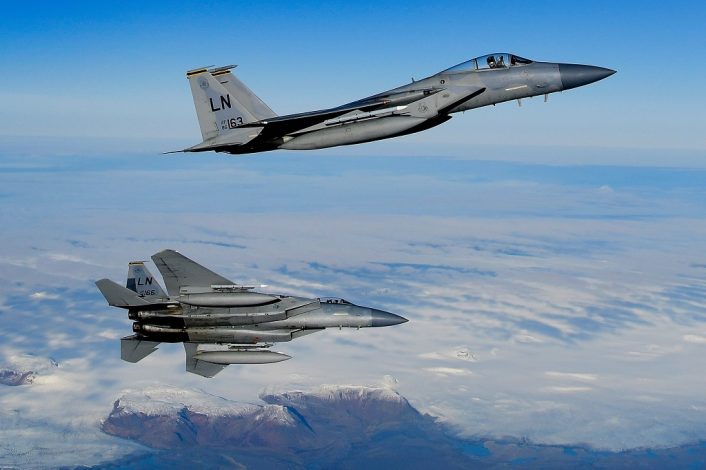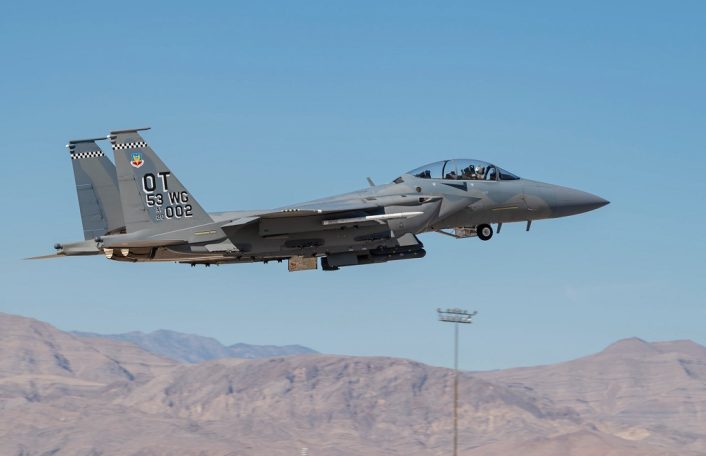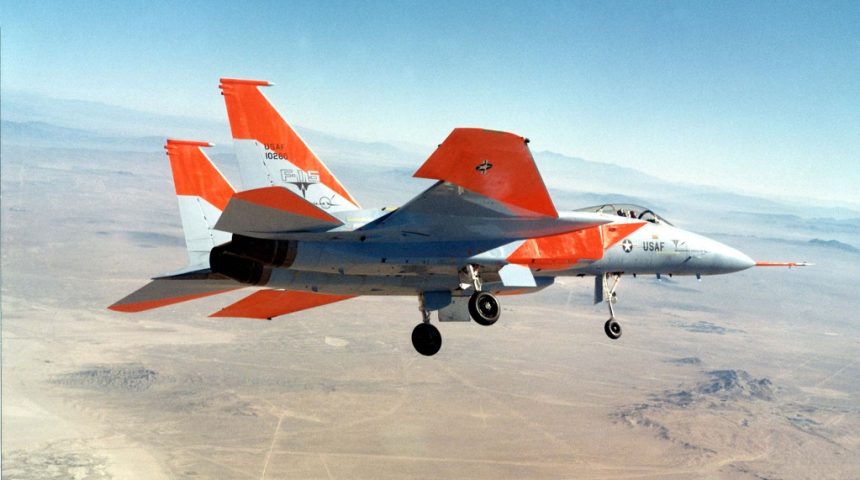July 27, 1972 marked the beginning of a new era in air superiority, with the first flight of the fighter jet that would rack up 104 aerial victories without ever being shot down by an adversary aircraft.
The McDonnell Douglas (now Boeing) F-15 Eagle celebrates today its 50th birthday, marking half a century of undefeated air dominance around the world. The prototype, YF-15A (s/n 71-0280), was rolled out of the McDonnell Douglas facilities in St. Louis, where all the F-15s were and are still being produced, on June 26, 1972. A month later, on July 27, under the control of McDonnell Douglas chief test pilot Irving L. Burrows, the Eagle took off for its first test flight over the California skies at Edwards Air Force Base.
Burrows took the U.S. Air Force’s new air superiority fighter on a 50-minute uneventful flight, up to 12,000 feet and 250 knots, discovering only a minor issue with a landing gear door. “It was just like the simulator,” he said. “This aircraft performed well from the first minute, we knew we had a winner from the start.”
#FighterFriday with a flashback flare.
Fifty years ago today, #F15 made it’s debut. Since then, the Eagle 🦅 has changed in many ways. One thing that’s not changed – #F15EX refuses to be second best, and continues to dominate the skies. pic.twitter.com/OjsQX24mKK
— Boeing Defense (@BoeingDefense) June 24, 2022
The first YF-15A prototype, painted in the USAF “Air Superiority Blue” livery with orange flight test markings, still had the square wingtips and an unnotched stabilator. Those features were later modified as initial flight testing led to the discovery of heavy wing bending and buffeting well within the operational envelope. After testing the new “racked” wingtip configuration, the Air Force was completely satisfied with the buffeting characteristics.
Several more flights occurred in the week that followed the first flight, which included milestones such as achieving Mach 1.5 speed and reaching an altitude of 45,000 feet. But the F-15 could do even better than that, and was used to break multiple records, including eight time-to-climb records that were held by the Soviet MiG-25.
Happy 50th Anniversary to the F-15!
The F-15 Eagle has remained one of the @usairforce‘s main 4th generation platform fighters since its inception. On July 27, 1972, test pilot Irving L. Burrows took the F-15 Eagle up for its first flight and the rest is history. #AlwaysReady pic.twitter.com/R9Wr9Hbz7R
— Air Combat Command (@aircombatcmd) July 27, 2022
For this purpose, an F-15 was stripped of everything that could be considered useless for the flights it was going to perform: speed brakes and flaps actuators, radar, cannon, tailhook, one generator, utility hydraulic system and even the paint. That aircraft became known as the “Streak Eagle” and broke the eight time-to-climb world records between January 16 and February 1, 1975. In setting the last of the eight records, it reached an altitude of 98,425 feet just 3 minutes, 27.8 seconds from brake release at takeoff and “coasted” to nearly 103,000 feet before descending.

A total of 12 pre-production F-15s were built, including two twin-seater aircraft initially designated TF-15 and later F-15B, and the new twin-engine fighter jet was approved by the USAF for full-rate production just six months after its first flight test. In 1974 the first Eagle, an F-15B, was delivered to the Air Force, while in 1976 the first F-15 for a combat squadron was delivered to the then 555th Tactical Fighter Squadron (now FS) “Triple Nickel”.
The same year Israel became the first export operator of the Eagle, locally designated “Baz” (Falcon) under the Peace Fox program. On June 27, 1979, the Israeli F-15s would become the first to shoot down an enemy aircraft, starting the unrivalled record of 104 kills and 0 losses against adversary aircraft throughout various conflicts.
The F-15 was a revolutionary leap forward, as hoped by the McDonnell-Douglas team behind its development. “It was designed with energy maneuverability in mind with the most power we could put on an airplane with two Pratt & Whitney F-100 engines at the top of their game and with the biggest radar that we can put on an air-to-air fighter in the APG-63 out of Hughes which later became Raytheon,” said Greg “Sherlock” Watson, IPT lead for the F-15 Division at Wright-Patterson AFB. “We could fly further, we could fly faster, we could fly longer than any other fighter out there.”
The F-15 was not only a powerful and capable aircraft, but also very survivable. The most famous example of this is that time an Israeli F-15D landed with only one wing. In fact, on May 1, 1983, the F-15D suffered a catastrophic mid-air collision with an A-4 Skyhawk, which resulted in the Eagle’s right wing being sheared off 60 cm from the root. The aircraft landed at twice its usual speed to compensate for the missing lift after losing the wing.
The Eagle evolved over the time, with the new F-15C and D variants being delivered in 1979, which featured multiple improvements and a higher maximum takeoff weight. In 1983 the Multi-Stage Improvement Program (MSIP) was initiated to provide the fleet with improved radar, central computer, weapons and fire control, and threat warning systems. The MSIP II some years later had its major focus on the APG-70 radar and the AIM-120 AMRAAM.

In 1986 flew for the first time a new variant, the F-15E Strike Eagle, selected as replacement for the F-111 Aardvark as part of the Enhanced Tactical Fighter program. The Strike Eagle still retains the same air-to-air capabilities of the Eagle, with the added capability to employ every air-to-ground munition in the USAF inventory. The F-15E became then the base to develop newer variants, like for example the Israeli F-15I “Ra’am”, the Saudi F-15S and F-15SA, the Qatari F-15QA and the latest F-15EX Eagle II.
As already reported here at The Aviationist, the new Eagle II, developed from the F-15QA that was until now the most advanced Eagle variant, comes from a series of needs mainly emerged after the National Defense Strategy directed the U.S. armed services to adapt to the new threats from China and Russia. The aircraft, while extremely similar to the QA variant, features some US-only capabilities like the new AN/ALQ-250 Eagle Passive Active Warning Survivability System (EPAWSS) electronic warfare and electronic surveillance system and Open Mission Systems (OMS) architecture.
The aircraft presents many differences compared to the F-15C that it will replace. For an instance, the F-15EX Eagle II is a two seats aircraft, which will have the option to fly with a single pilot or with both pilot and Weapons Systems Officer (WSO), while the -C model is mainly single seat and has a dedicated two seats -D variant for training. Originally both a single and two seat variants were proposed, called F-15CX and F-15EX respectively.
Another difference is that the F-15EX has a full glass cockpit equipped with a 10×19-inch touch-screen multifunction color display and JHMCS II both in the front and rear cockpit, Low Profile HUD in the front, stand-by display and dedicated engine, fuel and hydraulics display, in addition to the standard caution/warning lights, switches and Hands On Throttle-And-Stick (HOTAS) controls, as opposed to the F-15C that it is going to replace, which has a mainly analogic cockpit with some new displays added in the recent years.

In 2019, the decision was made to allocate the funding for the first eight of at least 144 F-15EXs, as this would be a more practical solution than waiting for enough F-35s to be available to replace also the F-15C. The Air Force confirmed in fact that the F-35 will replace some of the F-15C squadrons, while the other ones will be replaced by the F-15EX.
The 173rd Fighter Wing of the Oregon ANG, stationed at Kingsley Field, will become the first F-15EX Eagle II Formal Training Unit (FTU) in 2022, and the 142nd Fighter Wing of the Oregon ANG, stationed in Portland, will become the first F-15EX operational unit in 2023.
Even if now it’s 50 years old, it looks like the F-15 has still a lot of potential to be exploited and we will still see it flying around the world for a long time. The US Air Force, in fact, estimates that, with their 20,000 flight hours life, the F-15EX could potentially serve well into the 2040s or even the 2050s.









